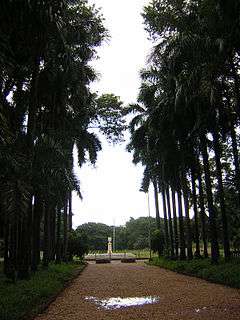Acharya Jagadish Chandra Bose Indian Botanic Garden
| Acharya Jagadish Chandra Bose Indian Botanic Garden of India | |
|---|---|
|
Acharya Jagadish Chandra Bose Indian Botanic Garden | |
| Type | Public |
| Location | Shibpur, Howrah |
| Nearest city | Kolkata, Howrah |
| Area | 109 hectares (270 acres) |
| Created | November 2, 1787 |
| Designer | Robert Kyd, William Roxburgh |
| Operated by | Botanical Survey of India |
| Status | open |
| Website | http://bsi.gov.in |
The Acharya Jagadish Chandra Bose Indian Botanic Garden (Hindi:आचार्य जगदिश चंद्र बसु भारतीय वानस्पतिक उद्यान) (previously known as Indian Botanic Garden)[1] is situated in Shibpur, Howrah near Kolkata. They are commonly known as the Calcutta Botanical Garden, and previously as the Royal Botanic Garden, Calcutta.[2] The gardens exhibit a wide variety of rare plants and a total collection of over 12,000 specimens spread over 109 hectares. It is under Botanical Survey of India (BSI) of Ministry of Environment and Forests, Government of India.
History
The gardens were founded in 1787 by Colonel Robert Kyd, an army officer of the British East India Company, primarily for the purpose of identifying new plants of commercial value, such as teak, and growing spices for trade.[3] Joseph Dalton Hooker says of this Botanical Garden that "Amongst its greatest triumphs may be considered the introduction of the tea-plant from China ... the establishment of the tea-trade in the Himalaya and Assam is almost entirely the work of the superintendents of the gardens of Calcutta and Seharunpore (Saharanpur)."[4]
A major change in policy, however, was introduced by the botanist William Roxburgh after he became superintendent of the garden in 1793. Roxburgh brought in plants from all over India and developed an extensive herbarium.[5] This collection of dried plant specimens eventually became the Central National Herbarium of the Botanical Survey of India, which comprises 2,500,000 items. During the early years of the garden Joseph Dalton Hooker writes:[6]
... contributed more useful and ornamental tropical plants to the public and private gardens of the world than any other establishment before or since. ... I here allude to the great Indian herbarium, chiefly formed by the staff of the Botanic Gardens under the direction of Dr. Wallich, and distributed in 1829 to the principal museums of Europe.
Over the years attractive display gardens for the public have been developed and many kinds of plants have been cultivated for scientific observation. During the 1970s the garden initiated a program to introduce improved food plants and other varieties of economic benefit to the people of India.
The Garden was designated the Acharya Jagadish Chandra Bose Indian Botanic Garden on June 25, 2009 in honor of Jagadish Chandra Bose, the Bengali polymath, and natural scientist.
This garden is a No Plastic Zone.
Attractions
The best-known landmark of the garden is The Great Banyan, an enormous banyan tree (Ficus benghalensis) that is reckoned to be the largest tree in the world, at more than 330 metres in circumference. It partially inspired the novel Hothouse by Brian Aldiss.[7] The gardens are also famous for their enormous collections of orchids, bamboos, palms, and plants of the screw pine genus (Pandanus).
Animals seen inside the Botanic Garden include the Jackal (Canis aureus), Indian mongoose and the Indian Fox (Vulpes bengalensis). A large numbers of varieties snakes also found in the garden.
Gallery
 A pond in Indian botanical garden
A pond in Indian botanical garden water lilies
water lilies- Roxburgh monument

References
- ↑ "Indian Botanic Garden, Howrah." BSI. Web. 28 Feb. 2011. <http://164.100.52.111/indianBotanicgarden.shtm>
- ↑ Mukherjee, Abhijit (2012). "Calcutta Botanic Garden". In Islam, Sirajul; Jamal, Ahmed A. Banglapedia: National Encyclopedia of Bangladesh (Second ed.). Asiatic Society of Bangladesh.
- ↑ "Robert Kyd".
- ↑ Joseph Dalton Hooker, Himalayan Journals, or Notes of a Naturalist ..., Kew (1854), vol. I, p. 5.
- ↑ Roxburgh, W (1814) Hortus Bengalensis or a catalogue of the plants growing in the Honourable East India Company's botanic garden at Calcutta. Mission Press : Serampore. 105pp.
- ↑ Joseph Dalton Hooker, Himalayan Journals, or Notes of a Naturalist ..., Kew (1854), vol. I, p. 4.
- ↑ "Brian Aldiss - Literary Legend".
- 225 years of Botanic History by Shakunt Pandey (PDF, 2.0 MB)
External links
| Wikimedia Commons has media related to Acharya Jagadish Chandra Bose Indian Botanic Garden. |
- Royal Botanic Garden, Calcutta Index, ca. 1830
- Botanical Survey of India
- ENVIS Centre on Floral Diversity
